Stars, those luminous celestial bodies, have fascinated humanity for millennia. These colossal structures not only illuminate the night sky but also play a crucial role in the creation of elements. The process of element formation in stars has long intrigued scientists, and recent research led by Dr. Ian Roederer of the University of Michigan has shed new light on this enigmatic phenomenon.
Stars generate elements primarily through fusion, a process that occurs within their cores. Fusion involves the amalgamation of atoms, resulting in the creation of heavier elements. Iron, the heaviest element formed through fusion, represents the pinnacle of this process. However, the fusion of iron into heavier elements demands substantially more energy than it generates. Consequently, stars undergo self-destruction when attempting to create elements beyond iron.
The Role of Supernovae and Kilonova Explosions
Supernova explosions, which mark the final stage in the life cycle of massive stars, and kilonova explosions, where two neutron stars collide, create an environment conducive to another element formation process known as rapid neutron-capture, or r-process. The r-process occurs when free neutrons assimilate onto available nuclei, resulting in the formation of heavier elements. This process provides an explanation for the existence of elements such as gold, platinum, thorium, and uranium. Nonetheless, many aspects of element creation via the r-process remain mysterious.
Dr. Roederer’s team sought to elucidate some of the unanswered questions surrounding element creation by investigating fission as an alternative formation mechanism. Unlike fusion, fission involves the splitting of an atom, resulting in the creation of less massive elements. The team focused on studying the chemical compositions of 42 well-studied old stars within the Milky Way that were likely to have produced elements through fission.
An Assembly of Observations
In their research, instead of analyzing the stars individually, the astronomers examined them collectively as a group. This unique approach allowed them to identify an intriguing pattern. By measuring the abundance ratios of specific elements, the team could ascertain whether the metals observed were produced through the r-process or fission. Surprisingly, the expected ratios indicative of the r-process were absent, leading the researchers to conclude that these elements were indeed formed through fission.
The implications of this discovery are profound. The heavy elements detected in the studied stars must have originated from early stars that produced elements exceeding an atomic mass of 260, which subsequently underwent fission to form lighter, more stable elements. These elements, with atomic masses greater than anything found naturally occurring on Earth, have eluded observation – both here on our planet and throughout the universe. While these elements have been artificially synthesized in laboratories, their short half-lives result in rapid decay.
The research carried out by Dr. Roederer and his team opens up new avenues of exploration for scientists. By studying the potential fission products of these heavy elements, researchers can gain insights into the likelihood and prevalence of their formation in the broader universe. Although the atomic mass of 260 represents uncharted territory, as it surpasses the heaviest elements previously detected on Earth or in space, understanding the conditions that enable such element fission can deepen our understanding of the universe’s chemical makeup.
As we delve deeper into the mysteries of the cosmos, we uncover tantalizing glimpses of the extraordinary processes that shape our universe. Dr. Roederer’s research provides invaluable insights into the origins of heavy elements and emphasizes the need for further exploration. By examining the chemical compositions of old stars, we can unravel the intricate story of element formation and gain a deeper appreciation for the celestial bodies that have illuminated our nights since the dawn of time.



Leave a Reply